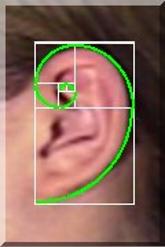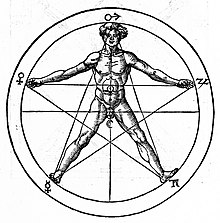
Is often correlated with the pattern of growth of Nautilaus shells.

Or the shape of the human ear.

The Golden Ratio is also found in the shape of a Pentagon/Pentagram. Here the colored segments are in Golden Ratio to each other.

And the human body maintains this aspect ratio.

People find the Golden Ratio everywhere. It constantly crops up in nature, and people use it in music, art, architecture, finance, etc.
The Golden Ratio is also a fractal.
A fractal is a mathematical equation that repeats itself on finer and finer scales. Think of it like this. You know when you look at the reflection of a mirror within a mirror you see the same thing repeated smaller and smaller? Like this:

No matter how small you get there's still a smaller version inside it? A fractal is the same thing but with mathematics. They tend to look pretty neat. And make good wallpapers.


Fractals are all over nature, where it becomes like the movie Pi. If you look, you are sure to find one. What does that mean? Who knows.
But all that is in my mind while I read this Cracked article about a guy who got beat near to death by some muggers, but as an unexpected result his brain was altered and now he essentially sees fractals. As in, when he looks at his hand, he sees the fractal shapes that make the hand. When he sees a cloud trail away, he sees the fractal spiral that makes that trail. I encourage everyone to read the story, I'm not doing the description justice. It's quite amazing.
Not only does he see fractals, he understands and has progressed the mathematics of fractals. The thing that has stuck with me from the article is that guy has found that Einsteins E=mc^2 equation is actually a fractal. And somehow this seems so very, very profound. I don't know why. I'm not a mathematician. I only know about these things on an intuitive sense. But it's something about the fact that one of the bedrock equations of physics now turns out to be a fractal. Fractals are found in nature a ton, but in physics? Now in physics.
So what does that mean? What is it about fractals? Repeating mathematical formulae, cropping up here and there and everything, in art, in nature, in physics. What does that mean for us? Are we just fractals? Are we just repeating mathematical formulae, replicating on infinite scales, through space and time? Everyone says history repeats itself, is human history a behavioral temporal fractal? If you crack the equation of the fractal, could you know the future?
I guess it's the same quantum equation people have been grappling with since fate and determination and mathematics intersected, but it's come through a lens of fractals. I don't know, I'm just rambling. A better man could make a story of this. Me, I'm just intrigued.